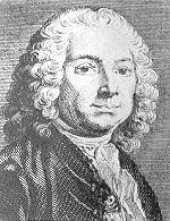Francesco Xaverio Geminiani was born in Lucca in 1687 from Giuliano and Angela. He was the fourth of eleven children, as we can infer from the certificate of baptism of December 5th, where we find the exact information about his second name - Xaverio and not Saverio. The events of his troubled biography show an original and important outline: from his youth in Italy - Lucca, Naples and Rome between 1687 and 1714 - through his first stay in London (1714-1732) to the many journeys through Europe (1732-1762). Although we have new information, the musical training of Geminiani remains a little obscure for us: probably he first studied with his father, who was a violinist in the Palatine orchestra of Lucca. Then he may have studied with Alessandro Scarlatti and Arcangelo Corelli during a very short stay in Rome, but this information is not supported by any document. And we know very little on his stay in Naples, where he certainly underwent a failure as director, because of the incapacity of the players in following his tempo rubato. But this happened probably after his work in the Palatine orchestra of Lucca, where he stayed two years (1707-1709) after his father’s death. The move to London in 1714 - in a period when a violinist could easily impose himself as a direct descendant of the beloved Corelli - and the publication in 1732 of the Concerti grossi op. 2 and 3 show us a relatively quiet period. During these eighteen years he reached such a prestige that his his adherence to the Masonry and his contribute to the foundation of the lodge Philomusicae et Architecturae Societas (1725) - better known as Queen’s Head, from the name of the tavern where the meetings took place - are crowned by his important election as perpetual dictator. At the same time a subscription was raised in order to publish the first six sonata of the op.5 by Corelli in a new arrangement for concerto grosso. The name of Geminiani appears also in the list of the supporters of the Academy of Vocal Musick together with the names of Giovanni Bononcini and Nicola Haym. In 1728 Geminiani refused the opportunity offered by the Earl of Essex to work as Master and composer of the national music in Ireland, because he ought to have abjured the catholic religion. And besides the faith motivations, his refusal is explained by the intention of eluding the restrictions imposed by a regular service, and maintaining an independent role from the Patrons - while accepting their protection and friendship. The renunciation to the economic security forced Geminiani to embark on risky commercial activities: he opened a Concert-Hall in Dublin, and used it also as an art-gallery to sell paintings - a great passion of his - by auction. Following the common practice he realized transcriptions, reviews and arrangements that he printed with great difficulties at his own expenses. After the concerti grossi op.2 and 3 edition, that met with an outstanding success which has still no equal, there are the sonata for violin op. 4, the sonata for violoncello op. 5, the concerti grossi op. 7, the Foresta incantata, and the many treatises, between which we can mention the Guida armonica (1742), heavily criticized, and The Art of Playing on the Violin (1751), that is one of his most famous works - if we consider the number of editions. The frequent moves between Dublin, London and Paris demonstrate the difficult conditions this composer had to suffer in the years of his old age too, and until his death in Dublin on September 17th in 1762. As any other violinist of his generation, Geminiani took Corelli and his musical forms - sonata and concert - as reference points, but he introduced some original elements of style, as a greater freedom in the rhythmic and thematic arrangement, the richness of sonority and the exceptionally developed instrumental virtuosity. From the point of view of the formal articulation, the Corellian model of the Church Sonata, which is a series of four movements with contrasting characteristics - lento, veloce, lento, veloce - is almost always applicable to either the sonatas or the concerts of Geminiani. Although he did not accept the new proposals connected with the spreading of the three movements solo concert, there are some clear signs of an instrumental research which has the aim of exceeding the Italian tradition of the late Baroque Age. In the repertory of the sonata, which is usually conservative, we can report the interest for instruments that are not a violin. This interest finds its top in the two collections of pieces for harpsichord - efficaciously rearranged in famous compositions of the op.1 and 4 - and in the series of sonatas for violoncello, where we can see a profound knowledge of the instrument itself and of its technical possibilities. In the concerti grossi the contrast between solos and ripienos is realized in many combination, also because of the addition of a viola to the usual concertino of two violins and one violoncello. The eccentric use of the chromatism and of particularly expressive chords, as the Neapolitan sixth and the seventh faded out - that were the most serious and tense for that period - surprise us a lot.
Instrumental music
6 Concerti Grossi op. 2










